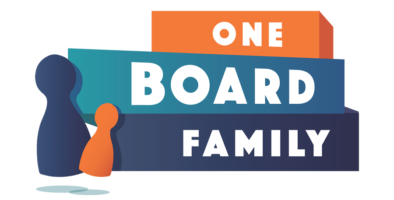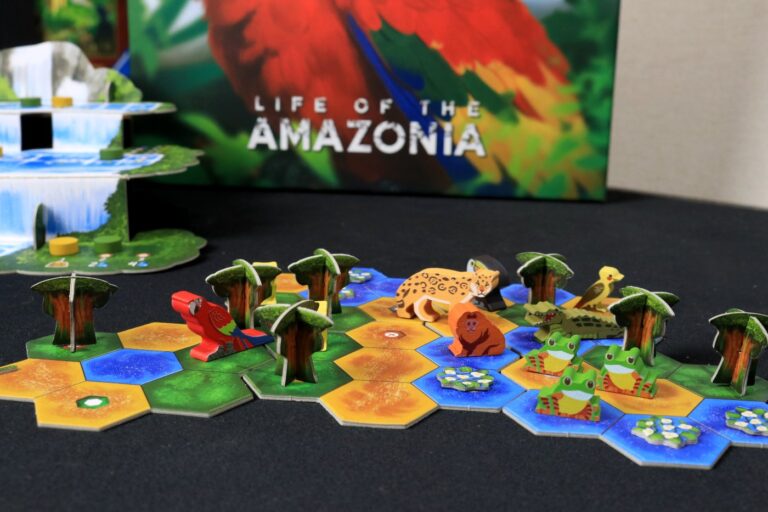In Tribes of the Wind, players control a tribe that is working to rebuild society after pollution left the land uninhabitable. Your group of wind riders will plant forests, clear pollution, build temples and villages on individual player boards. Prepare to ride the wind and rebuild civilization.
Life in the Treetops
Each player is populating their individual player boards that are filled with pollution tokens. You’ll draft and place forest tokens throughout your player board, setting the foundation for the building of temples and villages. Cards from 5 different elements are used to gather the resources and trigger the actions you need. How these actions play out will depend on the cards that the other players at the table are holding.

Tribes of the Wind relies heavily on iconography across the 5 cards that will sit in their card holder. On the back of the card is its element type which is visible to all other players. Sometimes cards will require that you have less or more cards of a specific element than your neighbors at the table. These cards are reliant on what else is at the table in order to be played.
While some of the icons work well, we find ourselves referencing the rulebook often if we haven’t played the game in a couple weeks. Players will get more familiar with more sessions, but those first couple games can be really clunky. The game needs a simple player aid card, which is a big miss here.
Beyond the iconography, this mechanic of gaining actions or resources based on the cards your neighbors have works really well. It feels fresh, and it forces players to adjust their strategies on the fly.

Captain Planet
Player boards start with pollution tokens keeping you from expanding right away. Finding the right combination of cards to clear the smog and make space for trees is imperative. Some forest tiles that are planted on your board can give travel benefits as you hop around with your wind riders. Planting some of the cheaper forest tiles produce additional pollution in adjacent spaces. With careful planning, you can keep new pollution at bay.
Victory points are gained through temples and villages that are built along with the reduction of pollution. Goal cards that can be collected during the game can be a big source of points or give players a quick boost during the game. Tribes of the Wind uses goal cards that either have a goal that can be achieved for end game points or an instant bonus. These multi-use goal cards work really well and the goals are pretty diverse.

Gone with the Wind
Tribes of the Wind has incredible artwork from the one and only Vincent Dutrait. The card illustrations are beautiful even though there isn’t a huge amount of variety among the 80 cards. The character illustrations on the player boards definitely stand out against the drab post-apocalyptic grid that you’re building on.
Designer Joachim Thôme did an excellent job creating a fresh mechanic with the card play. Inevitably, there will be moments where the cards you have don’t meet your need. Players can build 1 of 4 temples on their board by discarding 3 cards from their display. These temples also trigger additional bonuses. Refreshing your hand can also give you a path forward.

Even though I have a lot of love for the art and mechanics of Tribes of the Wind, each game I played has suffered from the same issue. The end game feels incredibly dull and anti-climatic. I’ve played the game at 2, 3 and 4 players with this same issue cropping up each time.
The game ends when one player at the table has built their 5th and final village. In most games, players are building at a relatively consistent pace. We usually see villages pop up on player boards within a round of one another as the resources start flowing.
Tribes of the Wind feels like a solo building experience with some dependencies on neighboring players. If a player doesn’t race toward building their 5th village, it often feels like you just max out all you can do as the game comes to a close.
This game is best when one player pushes the tension of the game as they build their final village. When playing to maximize end game points, you give the other players at the table the same opportunities. This often results in the point differentials on your goal cards deciding the winner.

Tribes of the Wind requires a couple plays for players to understand the pace of the game. This is a game where the seasoned player will have a significant upper hand against someone that hasn’t played the game before. In order to keep other players from maxing out their points, someone has to race to force the end of the game. It feels like this game could benefit from having multiple end game triggers to make this part of the game more dynamic.
Final Thoughts
It’s tough to find a way to tie up this review. Tribes of the Wind is a game I enjoy every time it hits the table. It can feel like a puzzle as you wait to play the right card to maximize your turn.
My issues with the end of the game doesn’t ruin the game for me, but it keeps the game from being one that I introduce to more people. With a few minor adjustments, it feels like this could have been a big hit. But for now, Tribes of the Wind is a game that will hit the table with a small group of friends and family. Mostly with people who have previously played the game before.
Tribes of the Wind is available at your local game store, the Hachette Games webstore or online through Amazon today.
This game was provided to us by the publisher for review. Read more about our review policies at One Board Family.
Highs
- Great artwork and fresh card mechanic
- Players can’t directly impact another players success
- Asymmetric character bonuses
- Turns are quick and engaging
Lows
- Iconography can be clunky, should have a player aid card
- End game feels dull and forgettable
Complexity

Time Commitment

Replayability






